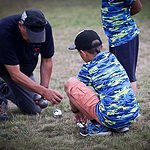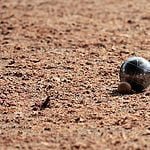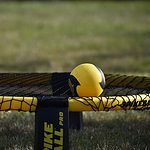When it comes to choosing between indoor and outdoor pickleball balls, understanding the nuances can significantly impact your game.
The physical characteristics and materials used in crafting these balls play a crucial role in determining their performance on different playing surfaces.
As you explore the distinct attributes of indoor and outdoor pickleball balls, you'll uncover how these factors can influence your gameplay and overall experience, ultimately helping you make an informed decision that aligns with your preferences and skill level.
Key Takeaways
- Indoor pickleballs have larger holes, affecting air resistance and wind coping.
- Outdoor pickleballs are heavier with smaller holes, influencing movement and power.
- Outdoor balls feature higher surface hardness for durability and bounce height.
- Players need to adapt to performance variations and optimize gameplay based on environment and ball characteristics.
Number of Holes
When comparing indoor and outdoor pickleball balls, the distinguishing factor of the number of holes significantly influences the aerodynamics and performance of the ball. Indoor pickleballs typically have 26 holes, whereas outdoor pickleballs feature 40 holes. The design variation in the number of holes between indoor and outdoor balls directly impacts how the balls move through the air and interact with the playing surface.
Indoor balls with fewer holes experience less air resistance, allowing them to move faster and have a more predictable trajectory. The wider holes on indoor balls contribute to this reduced air resistance compared to the closely-packed holes on outdoor balls. This characteristic makes indoor balls ideal for controlled plays and precise shots in indoor environments.
On the other hand, outdoor balls with more holes are designed to withstand outdoor conditions better. The higher number of holes helps outdoor balls to cope with wind interference and maintain stability during outdoor gameplay. The specific number and arrangement of holes on indoor and outdoor pickleballs cater to the unique requirements of each playing environment, ensuring optimal performance for players.
Hole Diameter
The variance in hole diameter between indoor and outdoor pickleballs plays a critical role in their performance characteristics on different playing surfaces.
- Indoor Pickleballs:
- Indoor pickleballs typically feature larger hole diameters.
- Larger hole diameters optimize performance on indoor courts by facilitating controlled flight and bounce characteristics.
- Outdoor Pickleballs:
- Outdoor pickleballs are designed with smaller hole diameters.
- Smaller hole diameters on outdoor pickleballs enhance durability and performance in outdoor conditions, where wind may affect flight characteristics.
The hole diameter of a pickleball significantly influences its flight and bounce characteristics. Indoor pickleballs, with their larger hole diameters, are tailored for precise play on indoor courts. In contrast, outdoor pickleballs have smaller hole diameters to withstand the rigors of outdoor environments and ensure consistent performance.
Understanding the impact of hole diameter on pickleball design is essential for players seeking optimal gameplay experiences indoors and outdoors.
Weight Variation
Indoor and outdoor pickleballs exhibit slight weight differences, attributed to the materials used in their construction. Outdoor pickleballs are heavier than indoor pickleballs due to the utilization of harder plastic material. The weight variance between the two types is less than 1%, but this slight difference significantly impacts gameplay. The heavier weight of outdoor pickleballs contributes to faster shots and more power on the court, enhancing the overall performance. On the other hand, indoor pickleballs, being lighter, provide better control and maneuverability during play, allowing for more precise shots and strategic gameplay. Weight is a critical factor in determining the playability of pickleballs, as it directly affects how the ball moves through the air and interacts with the paddle. The table below summarizes the weight variation between indoor and outdoor pickleballs:
| Feature | Indoor Pickleballs | Outdoor Pickleballs |
|---|---|---|
| Weight (grams) | 22.68 | 24.04 |
| Material | Lighter plastic | Harder plastic |
| Impact on play | Better control | Faster shots |
Surface Hardness
Utilizing harder plastic materials, outdoor pickleball balls exhibit a higher surface hardness compared to their indoor counterparts. This surface hardness plays a crucial role in the performance and durability of the balls during gameplay.
Here are some key points to consider:
- Durability: The harder plastic used in outdoor pickleball balls enhances their durability, making them more resistant to wear and tear, especially when used on rough outdoor surfaces.
- Crack Resistance: The increased surface hardness of outdoor balls helps prevent cracking, ensuring a longer lifespan even with repeated use on hard outdoor courts.
- Playing Experience: Indoor pickleball balls, with their softer plastic and lower surface hardness, offer a different playing experience suitable for indoor play, where the surface is typically smoother and less abrasive.
- Performance Impact: The surface hardness of pickleball balls directly affects factors like bounce height, speed off the paddle, and overall playability on indoor and outdoor courts.
Manufacturers consider these differences in surface hardness when designing pickleball balls to optimize performance based on the playing environment.
Material Differences
With distinct surface hardnesses influencing performance, the material variances between indoor and outdoor pickleball balls play a critical role in their gameplay characteristics and durability.
Indoor pickleballs are crafted from softer plastic with larger holes, providing a unique feel during play. The softer composition of indoor pickleballs offers a higher bounce and slower speed, enhancing control and precision in indoor settings.
In contrast, outdoor pickleballs are constructed from harder plastic with smaller holes to withstand the rigors of outdoor play. These outdoor pickleballs deliver a firmer feel, increased speed, and lower bounce to adapt to outdoor conditions effectively.
The durability of outdoor pickleballs is notably superior to their indoor counterparts due to the tougher materials used in their production. Understanding the material differences between indoor and outdoor pickleballs is crucial for players looking to optimize their performance and longevity on the court.
Bounce Characteristics
When comparing indoor and outdoor pickleball balls, the bounce characteristics are a key factor influencing gameplay dynamics and strategic decisions on the court. Understanding the differences in bounce between indoor and outdoor pickleballs is vital for players to adapt their gameplay effectively.
- Lower Bounce of Indoor Pickleballs: Indoor pickleballs tend to have a lower bounce than outdoor pickleballs. This reduced bounce is primarily due to the softer plastic material used in their construction.
- Higher Bounce of Outdoor Pickleballs: On the other hand, outdoor pickleballs offer a higher bounce. This increased bounce is a result of the harder plastic construction of outdoor balls, allowing for a more lively rebound off the court.
- Impact on Gameplay: The bounce characteristics directly impact gameplay strategies, shot selections, and positioning on the court, requiring players to adjust their techniques accordingly.
- Strategic Considerations: Players need to factor in the bounce differences when playing with indoor or outdoor balls to optimize their performance and make informed strategic decisions during matches.
Impact on Gameplay
The bounce characteristics of indoor and outdoor pickleball balls significantly impact gameplay dynamics and strategic decisions on the court, requiring players to adapt their techniques accordingly.
When comparing indoor versus outdoor play, the indoor balls are designed with smaller holes and a slightly larger diameter, leading to a more controlled bounce. Using an indoor ball in outdoor conditions can result in erratic bounces due to wind interference and surface inconsistencies, affecting player accuracy and shot predictability. It's essential to understand the nuances of each ball type to anticipate how they'll react on different surfaces.
The need to know how an indoor ball behaves on outdoor courts becomes crucial as players must adjust their positioning, timing, and shot selection to counter the unpredictable bounces. Successfully navigating these challenges demands quick thinking, adaptability, and a deep understanding of the game to maintain a competitive edge in outdoor pickleball environments.
Environmental Suitability
Outdoor pickleball balls are specifically crafted to withstand the environmental conditions and playing surfaces commonly encountered in outdoor settings such as tennis courts or concrete. When playing with outdoor pickleballs, there are key differences to consider:
- Harder Construction: Outdoor pickleballs are made with a harder composition compared to indoor balls. This hardness helps them withstand the rougher outdoor surfaces without getting damaged easily.
- Fewer Holes: Outdoor pickleballs have fewer and smaller holes than indoor balls. This design choice makes them more durable for outdoor play and ensures they can withstand the elements better.
- Impact on Playing: The harder construction and fewer holes of outdoor pickleballs can affect the way they bounce and move on outdoor surfaces. Players need to adapt their playing style to accommodate these differences for optimal performance.
- Environmental Adaptability: Players using outdoor pickleballs must be prepared to adjust to various outdoor conditions like wind, lighting, and different ball behavior on outdoor surfaces. Adapting to these factors is crucial for success in outdoor pickleball games.
Longevity and Durability
For enhanced longevity and durability in pickleball balls, the thickness and hardness of the plastic construction play a crucial role in withstanding wear and tear.
Outdoor pickleballs, designed with harder plastic, offer a longer lifespan compared to their indoor counterparts. The harder plastic used in outdoor balls makes them more resistant to cracking and deformation, ensuring they can endure the rigors of outdoor courts and rough playing conditions. This durability advantage means outdoor pickleballs are a more cost-effective choice in the long run, as their extended lifespan reduces the frequency of replacements.
On the other hand, indoor pickleballs, typically made of softer plastic, are more prone to wear and tear, leading to a shorter durability period. Therefore, if you prioritize durability and seek a ball that can withstand the demands of outdoor play, opting for pickleballs with harder plastic construction designed for outdoor use is the more reliable and cost-efficient choice.
Performance Considerations
Considering the performance differences between indoor and outdoor pickleballs, understanding their distinct characteristics is essential for optimizing gameplay experience.
- Lower Bounce and Slower Speed: Indoor pickleballs are designed to offer players better control with a lower bounce and slower speed, ideal for playing indoors where precise shots are crucial.
- Higher Bounce and Faster Speed: Outdoor pickleballs are engineered to provide a higher bounce and faster speed to accommodate the varied playing conditions found outdoors, allowing for quick and dynamic gameplay.
- Larger Holes in Indoor Pickleballs: The larger holes in indoor pickleballs contribute to their slower trajectory and speed, enhancing players' ability to place shots accurately during indoor matches.
- Smaller Holes in Outdoor Pickleballs: Conversely, outdoor pickleballs feature smaller holes that enable faster gameplay suitable for outdoor environments, where speed and agility play a key role in the game.
Understanding these performance considerations can help players choose the right pickleballs for their specific playing environment and style, ultimately enhancing their overall playing experience.





